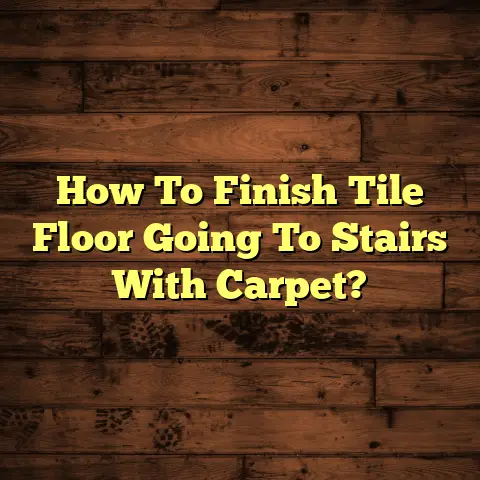Stop Wood Floors From Squeaking! (1 Quick Shim Trick!)
We’re living in a world where home improvement is booming. Everyone’s looking to upgrade, to add value, and let’s be honest, to make their place look amazing. And what’s a classic touch that everyone loves? Hardwood flooring! It’s beautiful, durable, and definitely boosts your home’s appeal.
But here’s the thing: even the most gorgeous hardwood floor can have its quirks. And the most annoying one? That dreaded squeak! Trust me; I get it. It’s not just about the noise; it’s about the feeling that something’s not quite right.
That’s why I’m here to share a super effective and surprisingly simple solution: the quick shim trick!
Understanding the Problem: What’s That Squeak?
So, what is a squeaky floor, really? It’s basically your floor telling you it’s unhappy. That noise? It’s the sound of wood rubbing against wood, or against a nail, or even the subfloor underneath.
Think of it like this: when you walk across a squeaky spot, you’re putting pressure on the floorboards. If they’re not properly secured, they’ll move slightly, creating friction and that annoying squeak.
What causes this? Well, there are a few usual suspects:
-
Natural Settling: Houses settle over time. It’s just a fact of life. This settling can shift the floor joists and subfloor, creating gaps where the floorboards can move.
-
Humidity Changes: Wood expands and contracts with changes in humidity. In the summer, your floors might swell, and in the winter, they might shrink. This constant movement can loosen the floorboards. According to the Forest Products Laboratory, wood can change dimensions by several percentage points depending on humidity. https://www.fpl.fs.fed.us/
-
Insufficient Support: Sometimes, the floor joists are spaced too far apart, or the subfloor is too thin. This can cause the floor to flex more than it should, leading to squeaks.
-
Installation Issues: A poor installation job can also be a major culprit. If the floorboards weren’t properly nailed or glued down, they’re more likely to squeak.
The type of wood matters too. Softer woods like pine are more prone to squeaking than harder woods like oak or maple. And the age of your floor definitely plays a role. Older floors are more likely to have loose nails and worn spots.
The Impact of Squeaky Floors: More Than Just Annoying
Okay, let’s be real. Squeaky floors are more than just a minor annoyance. They can actually have a real impact on your life and your home’s value.
Emotionally, they can be incredibly frustrating. That constant squeak, squeak, squeak can drive you nuts! It can disrupt your peace and quiet, make it hard to relax, and just generally create a sense of unease in your home.
Practically speaking, squeaky floors can be downright embarrassing. Imagine having guests over for dinner and every time someone walks across the room, it sounds like you’re living in a haunted house! It can definitely take away from the ambiance and make you feel self-conscious about your home.
And let’s not forget about resale value. When you’re trying to sell your home, first impressions matter. A potential buyer walking through your house and hearing squeaky floors might think there are bigger problems lurking beneath the surface. It can definitely detract from the overall value and make it harder to get the price you want.
I’ve seen it happen firsthand. A client of mine was trying to sell their beautiful Victorian home, but the squeaky floors were turning buyers off. Once we fixed the squeaks, they got an offer within a week!
The Quick Shim Trick: Silence Those Squeaks!
Alright, enough about the problem. Let’s get to the solution! The quick shim trick is a simple, effective way to stop those squeaky floors in their tracks.
Here’s a step-by-step guide:
Step 1: Identify the Squeaky Areas
This is the most important step. You need to pinpoint exactly where the squeaks are coming from. Walk slowly across the floor, paying close attention to where the noise is loudest. Mark those spots with painter’s tape. Don’t just assume you know where the squeak is coming from.
Step 2: Access the Floor Joists
Now, you need to get to the underside of the floor. If you have a basement or crawl space, this is easy. Just go down there and look up at the floor joists. If not, you might need to get creative.
-
Locate the Nearest Wall: Often, you can access the floor joists from the basement or crawl space near the wall closest to the squeaky spot.
-
Use a Stud Finder: If you can’t access the floor joists, you can try using a stud finder to locate the joists from above. This will give you a general idea of where they are.
Step 3: Gather Your Materials
You’ll need a few basic supplies:
- Shims: These are thin, tapered pieces of wood that you can use to fill gaps. You can find them at any hardware store. I prefer cedar shims because they are naturally resistant to moisture and insects.
- Construction Adhesive: This will help secure the shims in place. Make sure to choose an adhesive that’s compatible with wood. I recommend a polyurethane-based adhesive for its strong bond and flexibility.
- Hammer: You’ll need this to gently tap the shims into place.
- Utility Knife: For scoring and snapping shims to the correct width.
- Safety Glasses: Always protect your eyes!
Step 4: Insert the Shims
This is where the magic happens. Locate the gap between the floor joist and the subfloor directly beneath the squeaky spot. Gently insert a shim into the gap, with the thinner end going in first.
You want to fill the gap snugly, but not so tightly that you’re lifting the floor.
Step 5: Secure the Shims with Adhesive
Once the shim is in place, apply a generous amount of construction adhesive to both sides of the shim where it touches the joist and the subfloor. This will prevent the shim from moving and ensure a long-lasting fix.
Give the adhesive at least 24 hours to fully cure before putting any weight on the floor.
Step 6: Test the Floor
After the adhesive has cured, walk across the floor again to make sure the squeak is gone. If it’s still there, you might need to add another shim or adjust the existing one.
Benefits of Using Shims: Simple, Effective, and Affordable
Why shims? Well, they’re a fantastic solution for a few reasons:
-
Cost-Effective: Shims are cheap! You can buy a whole pack of them for just a few bucks. Compared to other methods like replacing floorboards or hiring a professional, this is a steal.
-
Easy to Use: You don’t need to be a master carpenter to use shims. The process is straightforward and requires minimal tools.
-
Non-Invasive: Unlike nails or screws, shims don’t damage the floorboards. They simply fill the gaps and provide support.
-
Adjustable: You can easily adjust the shims to get the perfect fit. If one shim isn’t enough, you can add another one.
I remember one time, I was helping a friend fix up his old farmhouse. The floors were a symphony of squeaks! We spent an afternoon using the shim trick, and it completely transformed the house. He was amazed at how simple and effective it was.
Preventative Measures: Stop Squeaks Before They Start
While the shim trick is great for fixing existing squeaks, it’s even better to prevent them from happening in the first place.
Here are a few tips:
-
Proper Installation: If you’re installing new hardwood floors, make sure to hire a reputable contractor who knows what they’re doing. A proper installation is key to preventing squeaks down the road.
-
Use the Right Fasteners: When installing the subfloor, use screws instead of nails. Screws hold tighter and are less likely to loosen over time.
-
Control Humidity: Keep the humidity levels in your home consistent. Use a dehumidifier in the summer and a humidifier in the winter.
-
Regular Maintenance: Inspect your floors regularly for loose boards or gaps. Address any issues promptly to prevent them from getting worse.
Conclusion: A Quiet Home is a Happy Home
So, there you have it! The quick shim trick is a simple, effective way to stop those annoying squeaky floors. It’s cost-effective, easy to do, and can make a huge difference in the comfort and value of your home.
Don’t let squeaky floors drive you crazy any longer. Take action today and enjoy the peace and quiet of a squeak-free home. I’m sure you’ll be glad you did!
References and Resources
-
The National Wood Flooring Association (NWFA): https://www.nwfa.org/ – Provides information on wood flooring installation, maintenance, and repair.
-
Forest Products Laboratory (FPL): https://www.fpl.fs.fed.us/ – Research on wood properties and behavior.
-
“Wood Flooring: A Complete Guide to Installation, Sanding, and Finishing” by Charles Peterson: A comprehensive guide to all aspects of wood flooring.
-
YouTube: Search for “fix squeaky floors with shims” for video tutorials demonstrating the shim trick.





